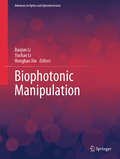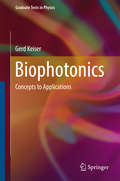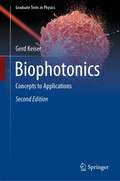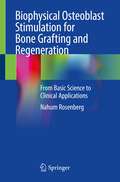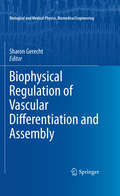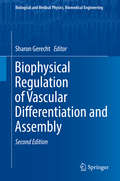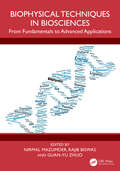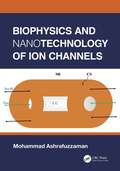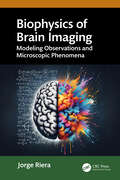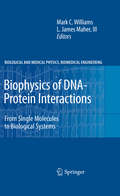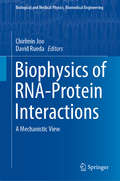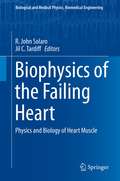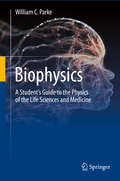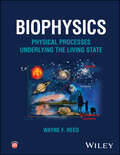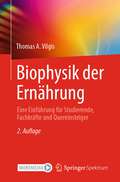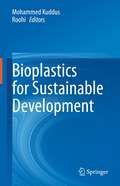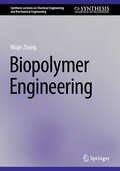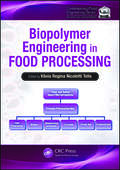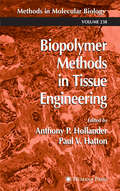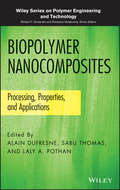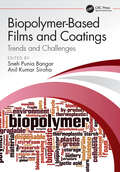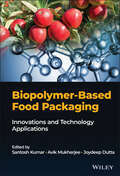- Table View
- List View
Biophotonic Manipulation (Advances in Optics and Optoelectronics)
by Baojun Li Yuchao Li Hongbao XinThis book offers a thorough overview of the rapidly expanding field of biophotonic manipulation, delving into topics such as the fundamentals of optical forces, technologies of optical manipulation, and their applications in the biomedical field. The recent recognition of Arthur Ashkin with the Nobel Prize for his groundbreaking work on optical tweezers has sparked a renewed interest and importance in the realm of optical manipulation. In response to this, the authors present a timely and comprehensive book that focuses on the basics and uses of various optical manipulation technologies, catering to a readership with a strong interest in this advancing field. This book not only enhances readers&’ current knowledge base but also serves as a valuable resource for researchers, scientists, and enthusiasts looking to gain a deeper understanding of the transformative power of optical manipulation.
Biophotonics: Concepts to Applications (Graduate Texts in Physics)
by Gerd KeiserThis book introduces senior-level and postgraduate students to the principles and applications of biophotonics. It also serves as a valuable reference resource or as a short-course textbook for practicing physicians, clinicians, biomedical researchers, healthcare professionals, and biomedical engineers and technicians dealing with the design, development, and application of photonics components and instrumentation to biophotonics issues. The topics include the fundamentals of optics and photonics, the optical properties of biological tissues, light-tissue interactions, microscopy for visualizing tissue components, spectroscopy for optically analyzing the properties of tissue, and optical biomedical imaging. It also describes tools and techniques such as laser and LED optical sources, photodetectors, optical fibers, bioluminescent probes for labeling cells, optical-based biosensors, surface plasmon resonance, and lab-on-a-chip technologies. Among the applications are optical coherence tomography (OCT), optical imaging modalities, photodynamic therapy (PDT), photobiostimulation or low-level light therapy (LLLT), diverse microscopic and spectroscopic techniques, tissue characterization, laser tissue ablation, optical trapping, and optogenetics. Worked examples further explain the material and how it can be applied to practical designs, and the homework problems help test readers' understanding of the text.
Biophotonics: Concepts to Applications (Graduate Texts in Physics)
by Gerd KeiserThis book introduces senior-level and postgraduate students to the principles and applications of biophotonics. It also serves as a valuable reference resource or as a short-course textbook for practicing physicians, clinicians, biomedical researchers, healthcare professionals, and biomedical engineers and technicians dealing with the design, development, and application of photonics components and instrumentation to biophotonics issues. The topics include the fundamentals of optics and photonics, the optical properties of biological tissues, light-tissue interactions, microscopy for visualizing tissue components, spectroscopy for optically analyzing the properties of tissue, and optical biomedical imaging. It also describes tools and techniques such as laser and LED optical sources, photodetectors, optical fibers, bioluminescent probes for labeling cells, optical-based biosensors, surface plasmon resonance, and lab-on-a-chip technologies. Among the applications are optical coherence tomography (OCT), optical imaging modalities, photodynamic therapy (PDT), photobiostimulation or low-level light therapy (LLLT), diverse microscopic and spectroscopic techniques, tissue characterization, laser tissue ablation, optical trapping, and optogenetics. Worked examples further explain the material and how it can be applied to practical designs, and the homework problems help test readers’ understanding of the text.This second edition provides updates as follows:1) Updated references in each chapter with recent review papers, tutorials, and generic research results.2) New sections in Chap. 3 addressing tapered fibers for sensors, biocompatibility issues of optical fibers, and concepts of implantable fibers.3) Updates in Chaps. 4 and 5 on optical sources and photodetectors discussing fiber-based sources, silicon photomultipliers, and high-speed cameras for biosensing.4): Sections on improvements in microscopy, imaging, spectroscopy, and sensing in Chapters 7–10. 5) New biophotonic application techniques in Chap. 11 will include optogenetic advances, smart phones for imaging, wearable biophotonic sensors, and robotic surgery and light therapy.
Biophysical Economy: Theory, Challenges, and Sustainability (Applied Ecology and Environmental Management)
by Steven M. BartellThis book explores the concept of transforming the current macroeconomic system from one based on continuous growth that doesn’t recognize the fundamental importance of Earth's natural support structures, to a system consistent with the basic views of biophysical economics that acknowledges that all real wealth ultimately derives from planetary resources, both renewable and non-renewable. It describes how data and information collected by various institutions, government agencies, and the private sector can be integrated with existing management structures to transform the “continuous growth” economy into an economy that functions within understandable boundaries on a finite planet. Features Stimulates discussions of the feasibility of a biophysical economy. Discusses the historical developments of biophysical economics. Offers a practical approach to building a biophysical economy. Explores the human experience of living in a biophysical economy. Emphasizes the fragility of life in the Universe as we know it. This book is an excellent resource for academics and students studying sustainable development, as well as for professionals working in the private sector and public institutions with an interest in economic planning for a sustainable future.
Biophysical Osteoblast Stimulation for Bone Grafting and Regeneration: From Basic Science to Clinical Applications
by Nahum RosenbergThis book integrates the current basic and clinical knowledge in the area of biophysical stimulation of osteoblast for in vitro and in vivo live bone generation. This innovative methodology and its applications are presented and discussed in several clinical conditions: treatment of fracture nonunion, spine stabilization, bone replacement after tumor resections, stabilization of failed joint endoprostheses in revision surgery and in treatment of bone loss (osteoporosis and osteopenia). The author analyses different types of biophysical stimulation of osteoblasts for bone regeneration, e.g. mechanical (static and alternating, including distraction osteogenesis), electromagnetic (pulsed, alternating, static), light (at different spectrum range, including laser), acoustic (including ultrasound), RF etc. Moreover, he summarizes and discusses the most significant findings for in vitro bone generation and its resulting clinical use as autologous bone graft without surgical morbidity. Reflecting the author’s extensive experience this book is an excellent source of knowledge and a valuable aid to clinical practice for all orthopedic surgeons, fellows, and researchers wanting to gain insights into this promising field.
Biophysical Regulation of Vascular Differentiation and Assembly (Biological and Medical Physics, Biomedical Engineering)
by Sharon GerechtBecause of their ability to differentiate and develop into functional vasculature, stem cells hold tremendous promise for therapeutic applications. However, the scientific understanding and the ability to engineer these cellular systems is still in its early stages, and must advance significantly for the therapeutic potential of stem cells to be realized. Stem cell differentiation and function are exquisitely tuned by their microenvironment. This book will provide a unique perspective of how different aspect of the vasculature microenvironment regulates differentiation and assembly. Recent efforts to exploits modern engineering techniques to study and manipulate various biophysical cues will be described including: oxygen tension during adult and embryonic vasculogenesis (Semenza and Zandstra), extracellular matrix during tube morphogenesis and angiogenesis (Wirtz, Davis, Ingber), surface topography and modification (Chen and Gerecht), shear stress and cyclic strain effect on vascular assembly and maturation (Vunjak-Novakovic and Niklason), and three dimensional space for angio-andvasculogensis (Ferreria and Fischbach).
Biophysical Regulation of Vascular Differentiation and Assembly (Biological and Medical Physics, Biomedical Engineering)
by Sharon GerechtThis book updates and expands on various aspects of the vasculature’s microenvironment and how these regulate differentiation and assembly. Discussed in this new edition are efforts to capitalize on combing engineering techniques, to study and manipulate various biophysical cues, including: endothelial cell- pericyte interactions (Davis), mechanical forces to regulate vascularization in three-dimensional constructs (Levenberg), how matrix properties and oxygen tension regulate vascular fate and assembly (Gerecht), biophysical cues in relation to vascular aging (Ferreira), 3D printing of complex vascularized tissue (Hibino), the harnessing of biophysical cues for therapeutic vasculature interfacing with the damaged brain (Segura) and finally, the infarcted heart (Grayson). This second edition of Biophysical Regulation of Vascular Differentiation and Assembly provides an interdisciplinary view of vasculature regulation thru various biophysical cues and presents recent advances in measuring and controlling such parameters. This book will be of interest to biologists, biophysicists and engineers who work with vascular differentiation and assembly.
Biophysical Techniques in Biosciences: From Fundamentals to Advanced Applications
by Nirmal Mazumder, Rajib Biswas, Guan-Yu ZhuoThis book details the latest advancements in spectroscopic, analytical and imaging techniques, emphasizing their crucial roles in both research and biomedical diagnostics. The initial chapters introduce the fundamental principles of the techniques, highlighting the use of optical spectroscopies for disease diagnosis, such as oral cancer. The book also explores their innovative applications, such as quantitative optical phase imaging, and the examination of biopolymers like starch through spectroscopy and microscopy. Further, the book discusses cutting-edge developments in biomaterials essential for understanding tissue engineering and the innovative use of synthesized bioactive glasses. The chapters also examine revolutionary methods such as HPLC and HPTLC techniques for detailed analysis at unprecedented scales and for observing various processes in health and disease. Importantly, the book reviews the impact of machine learning in enhancing the accuracy of disease diagnoses through nonlinear optical microscopy. The book also presents technological breakthroughs in the transformative impact of these techniques in developing diagnostic and therapeutic solutions. This book is intended for students, researchers, and professionals in biophysics, medical imaging, and biomedical engineering.Key Features: Highlights innovative applications such as quantitative optical phase imaging and the use of spectroscopy in disease diagnosis Explores the fundamental principles of advanced spectroscopic and imaging techniques Demonstrates the role of new technologies like synthesized biomaterials and applications of HPLC techniques Discusses the integration of machine learning with nonlinear optical microscopy to enhance the accuracy of disease diagnoses Presents the latest developments in biomaterials that are revolutionizing tissue engineering
Biophysics and Nanotechnology of Ion Channels
by Mohammad AshrafuzzamanThis book provides a comprehensive review of the biophysics and nanotechnology of ion channels. It details the biological and physiological entities of ion channels in cells and addresses various physical perspectives of ion channel structures and functions. Naturally inbuilt and artificial applicable nanotechnologies of ion channels are modelled and explored. It discusses various methods that can be utilized toward understanding ion channel-based cellular diseases. Physical, biochemical, biomedical, and bioinformatics techniques are taken into consideration to enable the development of strategies to address therapeutic drug discovery and delivery. This book will be of interest to advanced undergraduate and graduate students in biophysics and related biomedical sciences in addition to researchers in the field and industry. Features: Provides a stimulating introduction to the structures and functions of ion channels of biological cell membranes and discusses the biophysics of ion channels in condensed matter state and physiological condition Addresses natural processes and nanotechnology opportunities for their purposeful manipulation Lays the groundwork for vitally important medical advances Mohammad Ashrafuzzaman, a biophysicist and condensed matter scientist, is passionate about investigating biological and biochemical processes utilizing the principles and techniques of physics. He is an associate professor at King Saud University’s Biochemistry Department of College of Science, Riyadh, Saudi Arabia, the co-founder of MDT Canada Inc., and the founder of Child Life Development Institute, Edmonton, Canada. He also authored Nanoscale Biophysics of the Cell and Membrane Biophysics.
Biophysics of Brain Imaging: Modeling Observations and Microscopic Phenomena
by Jorge RieraThis book takes a multiscale overview and theoretical framework for all existing brain imaging modalities. It also presents technological development for data fusion and underlying biophysical models. The book also provides problems and exercises useful for undergraduate and graduate courses.Biophysics of Brain Imaging is broken up into 3 parts. Part 1: Modeling Observations and Microscopic Phenomena provides the physical and physiological foundation of all brain imaging modalities. Part 2 (Edited): Measuring and Modeling Emergent Mesoscopic Phenomena examines recording techniques and biophysical models used today to represent the mesoscale of the brain, the voxel. Part 3: Hypothesis Testing and Applications discusses methods to analyze brain imaging data and their applications to evaluate signatures in a variety of diseases, e.g., epilepsy, AD, and migraine.This book is intended for undergraduate and graduate level students in Computational Neuroscience, Medical Imaging, Electrophysiology, and Brain Data Analysis and Modeling courses.Figure slides are available to adopting professors.
Biophysics of DNA-Protein Interactions: From Single Molecules to Biological Systems (Biological and Medical Physics, Biomedical Engineering)
by L. James Maher III Mark C. WilliamsDepite the rapid expansion of the field of biophysics, there are very few books that comprehensively treat specific topics in this area. Recently, the field of single molecule biophysics has developed very quickly, and a few books specifically treating single molecule methods are beginning to appear. However, the promise of single molecule biophysics is to contribute to the understanding of specific fields of biology using new methods. This book would focus on the specific topic of the biophysics of DNA-protein interactions, and would include the use of new approaches, including both bulk methods as well as single molecule methods. This would make the book attractive to anyone working in the general area of DNA-protein interactions, which is of course a much wider market than just single molecule biophysicists or even biophysicists. The subject of the book will be the biophysics of DNA-protein interactions, and will include new methods and results that describe the physical mechanism by which proteins interact with DNA. For example, there has been much recent work on the mechanism by which proteins search for specific binding sites on DNA. A few chapters will be devoted to experiments and theory that shed light on this important problem. We will also cover proteins that alter DNA properties to facilitate interactions important for transcription or replication. Another section of the book will cover the biophysical mechanism by which motor proteins interact with DNA. Finally, we will cover larger protein-DNA complexes, such as replication forks, recombination complexes, DNA repair interactions, and their chromatin context.
Biophysics of Insect Flight (Springer Series in Biophysics #22)
by N. Chari Prasad Mukkavilli Laxminarayana ParayitamThis book basically involves the study of flight parameters, wing beat frequency, moment of inertia, and wing movements for developing various aerodynamic forces which have been calculated. The book is intended for biologists, physicists, nanotechnologists, and aerospace engineers. Resilin, an elastic polymer (4 λ) which is present at the base of insect, plays a major role in Neurogenic and Myogenic insect flyers and influences the physiology of flight muscles. Leading edge vortex (LEV) is a special feature of insect flight. Insect wings have stalling angle above 60 degrees as compared to a man-made aeroplane stalling angle which is 16 degree. Reynolds number, the knowledge of LEV, and detailed study of moment of inertia help in developing flapping flexible wings for micro-aerial-vehicles. This book serves as an interface between biologists and engineers interested to develop biomimicking micro-aerial-vehicles. The contents of this book is useful to researchers and professionals alike.
Biophysics of RNA-Protein Interactions: A Mechanistic View (Biological and Medical Physics, Biomedical Engineering)
by David Rueda Chirlmin JooRNA molecules play key roles in all aspects of cellular life, but to do so efficiently, they must work in synergism with proteins. This book addresses how proteins and RNA interact to carry out biological functions such as protein synthesis, regulation of gene expression, genome defense, liquid phase separation and more.The topics addressed in this volume will appeal to researchers in biophysics, biochemistry and structural biology. The book is a useful resource for anybody interested in elucidating the molecular mechanisms and discrete properties of RNA-protein complexes. Included are reviews of key systems such as microRNA and CRISPR/Cas that exemplify how RNA and proteins work together to perform their biological function. Also covered are techniques ranging from single molecule fluorescence and force spectroscopy to crystallography, cryo-EM microscopy, and kinetic modeling.
Biophysics of the Failing Heart: Physics and Biology of Heart Muscle (Biological and Medical Physics, Biomedical Engineering)
by Jil C. Tardiff R. John SolaroSubjects in the monograph "Biophysics of the Failing Heart" include state of the art chapters considering major biophysical mechanisms for why hearts responding to acquired or inherited stressors enter into maladaptive processes eventually leading to an inability of the heart to respond efficiently to hemodynamic loads especially during exercise. The chapters describe biophysical techniques that have been applied to determine the triggers for the heart failure process as well as the mechanisms for sustaining the disorders. These techniques include measurements of active and passive mechanical properties and hemodynamics at levels of organization ranging from molecules to hearts beating in situ. Biophysical concepts and approaches are also applied to determination of signaling and signal transduction, energetics, ionic currents, transport processes, electro-chemical and chemo-mechanical coupling. By its emphasis on biophysical aspects of a prevalent clinical condition, the monograph is unique in its perspective and focus. The breadth of information in the chapters all in one place will be of value to clinicians and researchers at all levels. Modern research approaches and clinical understanding of heart failure demands integration of multiple aspects of the disorders. In most cases, combinations of clinician scientists and researchers author the chapters. A main benefit of the book is couched in its didactic approach together with its emphasis on how biophysical concepts and techniques aid in diagnosis and development of new therapies.
Biophysics: A Student’s Guide to the Physics of the Life Sciences and Medicine
by William C. ParkeThis comprehensive and extensively classroom-tested biophysics textbook is a complete introduction to the physical principles underlying biological processes and their applications to the life sciences and medicine. The foundations of natural processes are placed on a firm footing before showing how their consequences can be explored in a wide range of biosystems. The goal is to develop the readers’ intuition, understanding, and facility for creative analysis that are frequently required to grapple with problems involving complex living organisms. Topics cover all scales, encompassing the application of statics, fluid dynamics, acoustics, electromagnetism, light, radiation physics, thermodynamics, statistical physics, quantum biophysics, and theories of information, ordering, and evolutionary optimization to biological processes and bio-relevant technological implementations. Sound modeling principles are emphasized throughout, placing all the concepts within a rigorous framework. With numerous worked examples and exercises to test and enhance the reader’s understanding, this book can be used as a textbook for physics graduate students and as a supplementary text for a range of premedical, biomedical, and biophysics courses at the undergraduate and graduate levels. It will also be a useful reference for biologists, physicists, medical researchers, and medical device engineers who want to work from first principles.
Biophysics: An Introduction (Springer Series In Biophysics Ser. #5)
by Roland GlaserBiophysics is the science of physical principles underlying all processes of life, including the dynamics and kinetics of biological systems.This fully revised 2nd English edition is an introductory text that spans all steps of biological organization, from the molecular, to the organism level, as well as influences of environmental factors. In response to the enormous progress recently made, especially in theoretical and molecular biophysics, the author has updated the text, integrating new results and developments concerning protein folding and dynamics, molecular aspects of membrane assembly and transport, noise-enhanced processes, and photo-biophysics. The advances made in theoretical biology in the last decade call for a fully new conception of the corresponding sections. Thus, the book provides the background needed for fundamental training in biophysics and, in addition, offers a great deal of advanced biophysical knowledge.
Biophysics: Physical Processes Underlying the Living State
by Wayne F. ReedAn introduction to the physics of living organisms The field of biophysics employs the principles of physics to study biological systems, and introduces the concept of the living state. It is a multidisciplinary approach to the study of the living state combining physics, biochemistry, molecular and cell biology, medicine and engineering. The physics of macromolecules and macromolecular assemblies is a particularly important aspect of this broader field. Biophysics: Physical Processes Underlying the living state offers an introduction to the general principles of the living state and their biological applications. Beginning with an historical overview of fundamental scientific theories and fields, the book then provides a brief introduction to cell biology and biochemistry, and then an overview of basic thermodynamics, kinetics, information theory, electrostatics in solution, fluid mechanics and macromolecular physics, and their relationship to the living state. After a presentation of physical methods, with an emphasis on light scattering, different biological macromolecules, selected aspects of their functions, and their physical properties and interactions are surveyed. A brief introduction to vision, biomotion, and theoretical biology is also provided. Exploration of some frontier issues in prebiotic origins of life, consciousness, and astrobiology round out the book. The result is a multifaceted window into the broad and evolving field of biophysics. Biophysics readers will also find: Problems at the conclusion of each chapter to reinforce and focus student knowledgeA gathering of topics in basic physics and physical chemistry which are seldom found in a single source This textbook is suitable for physics and engineering students studying biophysics, macromolecular science, and biophysical chemistry, as well as for polymer scientists, chemists, biochemists, cell and molecular biologists, bioengineers, and others.
Biophysik der Ernährung: Eine Einführung für Studierende, Fachkräfte und Quereinsteiger
by Thomas A. VilgisVerstehen Sie die unzähligen, widersprüchlichen Ernährungsempfehlungen nicht mehr? Können Sie beim Cholesterin nur ganz schwer zwischen Gut und Böse unterscheiden? Sind Sie hin- und hergerissen zwischen verschiedenen Ernährungsregeln und Ernährungsformen, die täglich auf Sie hereinprasseln, und verzweifeln am Begriff „gesunde Ernährung“? Oder sind Sie beruflich, z. B. als Berater oder Fitnesscoach, mit Fragen zum Thema Ernährung konfrontiert und möchten sich die naturwissenschaftlichen Grundlagen aneignen? Der Autor Thomas Vilgis rät, dabei erst einmal gelassen zu bleiben und sachlich über alle Mutmaßungen, Vermutungen, Versprechen und Orientierungsvorschläge nachzudenken.Dieses Buch führt Sie abseits ausgetretener Pfade und mit naturwissenschaftlicher, nüchterner Sicht an grundsätzliche Fragen der Ernährung heran. Ausgehend von der Ernährungsgeschichte des Homo sapiens begleitet Sie der Autor in das grundlegende Zusammenspiel zwischen Proteinen, Fetten und Kohlenhydraten, was sie im Körper bewirken, wie sie verdaut werden und welche Rolle sie wirklich spielen. Unterstützend finden Sie in der zweiten Auflage verschiedene abrufbare Videos, in denen komplexe Zusammenhänge anschaulich erklärt werden. So zeigt sich rasch, wie wenig sich hinter manchen zweifelhaften Aussagen verbirgt. Mit dem Anspruch einer naturwissenschaftlichen und molekularen Sicht auf die Ernährung gelingt es, auf verständliche und unterhaltsame Weise so manche fragwürdige Empfehlung zur Ernährung zu relativieren und einzuordnen.
Bioplastics for Sustainable Development
by Mohammed Kuddus RoohiThis book provides the latest information on bioplastics and biodegradable plastics. The initial chapters introduce readers to the various sources and substrates for the synthesis of bioplastics and biodegradable plastics, and explain their general structure, physio-chemical properties and classification.In turn, the book discusses innovative methods for the production of bioplastics at the industrial level and for the microbial production of bioplastics. It highlights the processes that are involved in the conversion of agro-industrial waste into bioplastics, while also summarizing the mechanisms of biodegradation in bioplastics.The book addresses a range of biotechnological applications of bioplastics such as in agriculture, food packaging and pharmaceutical industry, as well as biomedical applications.
Biopolymer Engineering (Synthesis Lectures on Chemical Engineering and Biochemical Engineering)
by Wujie ZhangThis book introduces engineering students and practitioners to biopolymers, which are polymers derived partially or entirely from biobased (renewable) raw materials, and/or are biodegradable. Biopolymers have unique properties such as biocompatibility, making them valuable in diverse industries. Both natural and synthetic biopolymers have been widely used across various fields, including for biomedical, food, and environmental applications. The book explains the fundamentals of biopolymer engineering and how biosynthetic and biochemical pathways enable the design and manufacturing of biopolymers. It then describes their properties and applications in the food industry, biomedicine and environmental engineering. The book can serve as a textbook for engineering students, including those in bioengineering, materials science and engineering, and biochemical engineering, and as a reference for professionals who are looking to refresh their knowledge in the field.
Biopolymer Engineering in Food Processing (Contemporary Food Engineering)
by Vnia Regina Nicoletti TelisDue to their unique properties and ability to interact with other food components, biopolymers have traditionally played a major role in food processing. Biopolymer Engineering in Food Processing explores processing technology associated with biopolymer applications and discusses both operational and economic aspects.Following an overview of biopol
Biopolymer Methods in Tissue Engineering (Methods in Molecular Biology #238)
by Anthony P. Hollander Paul V. HattonExpert laboratory researchers describe in a standard format all the diverse laboratory methods needed to perform state-of-the-art tissue engineering. Topics range from the synthesis, processing, and characterization of specific biomaterials, through the successful use of scaffolds in the engineering of tissues, to techniques useful in evaluating the biological quality of scaffold-engineered tissues. Topics of special interest include the incorporation of biological molecules into scaffold biomaterials and the use of a wide range of methods and techniques to generate a comprehensive description of cell-polymer construct quality.
Biopolymer Nanocomposites
by Sabu Thomas Alain Dufresne Laly A. Pothan Domasius Nwabunma Richard F GrossmanSets forth the techniques needed to create a vast array of useful biopolymer nanocompositesInterest in biopolymer nanocomposites is soaring. Not only are they green and sustainable materials, they can also be used to develop a broad range of useful products with special properties, from therapeutics to coatings to packaging materials. With contributions from an international team of leading nanoscientists and materials researchers, this book draws together and reviews the most recent developments and techniques in biopolymer nano-composites. It describes the preparation, processing, properties, and applications of bio- polymer nanocomposites developed from chitin, starch, and cellulose, three renewable resources.Biopolymer Nanocomposites features a logical organization and approach that make it easy for readers to take full advantage of the latest science and technology in designing these materials and developing new products and applications. It begins with a chapter reviewing our current understanding of bionanocomposites. Next, the book covers such topics as:Morphological and thermal investigations of chitin-based nanocompositesApplications of starch nanoparticle and starch-based bionanocompositesSpectroscopic characterization of renewable nanoparticles and their compositesNanocellulosic products and their applicationsProtein-based nanocomposites for food packagingThroughout the book, detailed case studies of industrial applications underscore the unique challenges and opportunities in developing and working with biopolymer nanocomposites. There are also plenty of figures to help readers fully grasp key concepts and techniques.Exploring the full range of applications, Biopolymer Nanocomposites is recommended for researchers in a broad range of industries and disciplines, including biomedical engineering, materials science, physical chemistry, chemical engineering, and polymer science. All readers will learn how to create green, sustainable products and applications using these tremendously versatile materials.
Biopolymer-Based Films and Coatings: Trends and Challenges
by Anil Kumar Siroha Sneh Punia BangarWith the growing concern for the environment and the rising price of crude oil, there is increasing demand for non-petroleum-based polymers from renewable resources. Biopolymer films have been regarded as potential replacements for synthetic films in food packaging due to a strong marketing trend toward environmentally friendly materials. Biopolymer-based films and coatings display good barrier properties, flexibility, transparency, economic profitability, and environmental compatibility. Therefore, they have successfully been used for packaging various food products. Biopolymer-Based Films and Coatings: Trends and Challenges elaborates on the recent methods and ingredients for making biodegradable films and coatings, as well as the current requirements for food security and environmental issues. This book also explores films and coatings prepared with essential oils, antimicrobial substances, and bioactive components that make up this active packaging. Films and coating chapters are based on biopolymers used to prepare films and coatings, that is, carbohydrates, lipids, proteins, and so on. This book provides a platform for researchers and industrialists on the basic and advanced concepts of films and coatings. Key Features Provides a comprehensive analysis of recent findings on biopolymers (carbohydrate-, protein-, and lipid-) based films and coatings Contains a wealth of new information on the properties, functionality, and applications of films and coatings Presents possible active and functional components and ingredients for developing films and coatings. Guides start-up researchers on where to start the latest research work in packaging It has been estimated that the global production of bioplastics is set to hike from ~2.11 in 2020 to ~2.87 million tonnes in 2025. Further, the demand for fresh, ready-to-eat, or semi-finished foods is increasing, and the need to maintain food safety and quality further exacerbates the challenges in the supply chain, especially with the globalization of food trade and the use of centralized processing facilities for food distribution. It is an urgent requirement to increase shelf life and reduce food product loss. Considering the great market demand for biodegradable material-based packaging systems, this book comes at an opportune time to enable researchers and food scientists to develop suitable solutions considering the sustainability and economic feasibility of the process.
Biopolymer-Based Food Packaging: Innovations and Technology Applications
by Santosh Kumar Joydeep Dutta Avik MukherjeeBiopolymer-Based Food Packaging Explore the latest developments and advancements in biopolymer-based food packaging In Biopolymer-Based Food Packaging: Innovations and Technology Applications, a team of accomplished researchers delivers a complete, systematic, and sequential account of the contemporary developments in the application of biopolymers for sustainable food packaging. This book introduces the fabrication, characterization as well as benefits arising from the enhanced functionalities of biopolymer-based food packaging materials. The authors introduce various polysaccharide, protein, and microbial polymer-based food packaging films and coatings, as well as biopolymer-based blends and nanocomposites. Importance of these materials as active and intelligent food packaging systems is also introduced. Finally, the book explores biopolymer-based edible food packaging, and its efficacy in extending the shelf-life of perishable food items using sustainable materials and processes suitable for the future of circular economies around the world. Readers will also find: A thorough introduction to the incorporation of nanomaterials as fillers to improve the physico-chemical, mechanical, thermal, barrier, optical, and antimicrobial properties of food packaging nanocomposites Comprehensive discussions of the use of plant-based bioactive compounds, including essential oils, in biopolymer-based food packaging Practical examinations of silver and zinc oxide nanoparticles in food packaging In-depth treatments of polylactic acid-based composites for food packaging applications Biopolymer-Based Food Packaging: Innovations and Technology Applications is an invaluable resource for academic researchers and professionals in food packaging and related industries, as well as research scholars, graduate students, and entrepreneurs working and studying in the field of food preservation, environmental safety, and human health with a focus on the sustainable future.
